Part of the summer travel series in The Matterhorn

This summer, I’m posting short vignettes of places as part of the Summer Travel Series on The Matterhorn. It’s part of our ongoing look at culture and internationalism. We’d love to hear from you in the comments if you’ve been to or know more about these places, or if the descriptions generate ideas and make you think of something differently.
The focus today is ‘local travel’ from my base in Basel - somewhere I can get to in less than two hours by train. On our discussion of why we travel a few weeks ago, we talked about the benefits of local travel quite a bit (especially environmental). I don’t known how long we’ll be living here, so I try to take the train somewhere new every other week or so, even if just for an afternoon. It helps that Swiss trains are amazing and if you’re local, you can buy a cheap card to go half price all year long. I read that the public transport here goes within a kilometer of every registered address in the country, which is pretty incredible if you consider all the mountainous regions!
The last time I visited Rigi was this April with my mother-in-law. We planned to do a little hike but when we got to the top with the mountain trains…it was snowing heavily and the paths were completely covered with ice! Everyone hopped off the train for about ten minutes to snap photos of ideas of distant mountains, then quickly hopped back on to catch it back down. Ah, the unpredictability of travel!
Thanks for reading! - Kate
Slowing down in the Swiss Alps
Mount Rigi — the Queen of the Mountains — is not especially tall (by Swiss standards) nor does it have the best ski pistes or après atmosphere. But her history gives every activity a layered subtext of culture. The routes are made slow by the original cogwheel mountain trains and allow every experience to become fully immersive.
There’s something for everyone on Rigi. In summer, there’s hiking, visiting cheese factories or farms, or paragliding for adrenaline seekers. In winter, most hiking trails can still be accessed by foot, snowshoe, toboggan, or nordic ski. The grazing pastures are covered with snow and once invisible ski trails cover the landscape.
Summer
I first went to Rigi in the summer with a friend in town from New York. We had pre-planned our trip and the weather was unfortunately cold and wet. Worse than getting hypothermia, we worried our experience would be pointless without the famous views.
At first, it seemed so. We slowly inched our way up the mountain, enveloped by fog. While the interior of the old train fascinated us, we were more concerned about how we would actually make our way around. At the top, the cold rain pelted us in our amateur gear.
But we started out. And we found, first, so much beauty in the immediate surroundings. In the trees and the path itself. In the small plants and rocks. In the cows that we encountered up-close after hearing their bells in the fog.
And finally, the fog began to lift as we walked. So rather than find the train again, we continued on, down steep, slippery hills and around stubborn farm animals. We began to see the view that had been elusive. It was as if the entire mountain range across the lake had been held in a cache, released to us only after enough effort and patience.
Winter
My next trip was with my husband and son, this time in the winter. This time, we also had the luck of two clear, sunny days just after a small snowstorm.
We decided not to be too ambitious with our three-year-old on the first day. Jumping on and off the railway, we were able to complete several 20–30 minute hikes with him on groomed snow trails. We saw winter sports around us and other cultural pleasures: horse and carriage rides, outdoor fondue, a band preparing for Fasnacht celebrations at the train stop.
The second day, we rented a sled for 10 CHF to drag our son along the panoramic trail. We encountered cross-country skiers, snowshoers, and other hikers. Each of us greeting the others with ‘Hallo!’ or ‘Grüezi!’ or ‘Morgen!’ and a smile, something that has been lost in our cosmopolitan experience.
The views were incredible. Amazing. Sublime. They can only be described in cliché and fail miserably.
At the top, there was a marked photograph of all the mountain peaks, all visible that day. And as I read each name protruding from a tiny line, hundreds of names, I could only recognise one or two peaks.
How does one make sense of all this vastness and beauty that has not been conquered by humans?
Intimate immensity
When on the mountain top, in the snow or atop the fog, we are protected from the dangers of the modern world — the infiltrations on our mind — we move slowly and we are present. Even in these two experiences during the global pandemic, people of different cultures and speaking different languages converge at train stops or mountain peaks. We are all again separated on our individual routes, often with no people in sight. We feel the space intimately, as if we are nothing, breathing in the world and dissipating into the universe.
As my husband says, we are all just little ducks, paddling and trying to stay afloat. The space of the vast mountains reminds us that we are minuscule. We can give ourselves over to now and to love — for nature, for ourselves, for humankind.
This ‘poetic space’ is what Gaston Bachelard calls ‘intimate immensity’ while drawing on Baudelaire’s poetry and spatial theories in The Poetics of Space (183–210). ‘Vast’ space is ‘slow and calm’; it ‘evokes calm, peace, and serenity’ (196).
Transportation transportation transportation
There are so many ways to move around Rigi and its vicinity that you might spend most of your day on transportation. That’s not necessarily a bad thing.
When we took my son on the two-hour panoramic trail from Rigi Kaltbad to Rigi Scheidegg, we had the added issue of bringing our sled back to the place we had rented it. That morning from our hotel in Weggis, we took a gondola up to Rigi Kaltbad. After the walk (which took us a little longer with the kid!), we had to take a different gondola down to Klosterli, then a slow train up to change to another slow train down back to return our sled. Finally, we took the gondola back to Weggis to collect our things and get on a ferry to Luzerne, where our train to Basel left just five minutes later.
It sounds like a royal pain. However, the journey became the experience. We had no goal. We had only the movement of our feet in the snow, the view of hundreds of mountain peaks, the sway of our gondola, and time travel inside old wooden train carriages.
Historical Cogwheel Railway
In 1871, the Vitznau-Mt. Rigi cogwheel train became the first mountain railway in Europe. Its opening created excitement about the touristic area and about the capabilities of Swiss technology. Now, there are many incredible journeys up mountains in Switzerland that you can take by rail.
On Rigi, there are two main lines that go up to Rigi Kulm (the top) from Arth-Goldau and Vitznau. There are further ‘sport trains’ that run in the winter just between several stops for skiers, sledders, and anybody else who wants a chairlift alternative.
Gondolas
7 gondolas and smaller cable cars also run between destinations to help you get around and to give you some awesome views.
Ferries
Boats connect Lucerne’s main train station (right in the city centre) conveniently to Vitznau (railway terminus) and Weggis (cable car).
Bachelard through Baudelaire again understands ‘vastness’ through the ‘movement of a ship’ (193). He quotes Baudelaire on the same page to talk about this ‘ship, [a] beautiful volume resting on the waters’:
The poetic idea that emanates from this operation of movement inside the lines is the hypothesis of a vast, immense creature, complicated but but eurhythmic, an animal endowed with genius, suffering and sighing every sigh and every human ambition.
The large boat has both indoor and outdoor seating for 2nd or 1st class passengers as well as table service, including drinks and meals. After a long day of hiking in the rain, my friend and I enjoyed wine in real glasses on the outdoor 1st class patio. Though we clung to our fragile glasses over the slightly turbulent waters in our rain gear, we felt like ladies of leisure from a different century.
There are other touristic boats you can take on Lake Lucerne for several hours to different destinations or to no destination at all.
Hiking trails
As I mentioned above, there are many activities you can enjoy on Mt. Rigi. Here, I recommend you leave your skis at home, unless you want to try a classical cross country route. Rigi’s pistes are nothing compared to other ski resorts nearby, although the beginner areas may be a good option for certain members of your group.
The joy of movement at Rigi is by slow transportation or slow feet that can stop frequently and connect with the earth below them.
Summer
Hiking trails on Mount Rigi are expansive and diverse, from 20 minute wanders to hours of technical terrain. Diversions also make the hikes fun. Try to include a stop at a cheese farm or restaurant to make it memorable.
Several websites offer further photos and anecdotal details of the hikes beyond the well marked trails and maps. These include hikeanddine.com and Swiss Family Fun.
Winter
Winter hiking trails are similarly well marked and maintained. The interactive map shows what is open and what is groomed specifically for skiers or walkers without snowshoes.
Restaurants are open in the winter and most have sunny terraces to enjoy when the weather is nice. Stay warmer with hot cheese or glühwein.
Mark Twain
For American literature lovers, add some culture to your journey with the Mark Twain trail, which you can do on your own or with a guide. Twain did a three-day hike here and documented it in “A Tramp Abroad.”
There, he explains his journey, including a shortcut down the mountain on the railway:
One expected to see the locomotive pause, or slack up a little, and approach this plunge cautiously, but it did nothing of the kind; it went calmly on, and went it reached the jumping-off place it made a sudden bow, and went gliding smoothly downstairs, untroubled by the circumstances.
It was wildly exhilarating to slide along the edge of the precipices, after this grisly fashion, and look straight down upon that far-off valley which I was describing a while ago.
Practical information
Where to stay
Hotels abound in Weggis, Vitznau, and Lucerne as well as at several stops atop the mountain. It depends on the activities you want to enjoy as well as if you have children traveling with you or not.
In the summer, we stayed at the friendly and practical city hotel in Lucerne called Hotel Central. Doubles roughly 180 CHF.
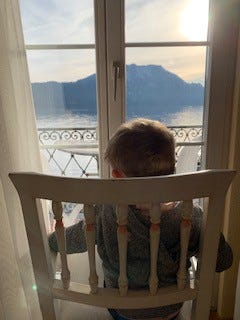
During the winter, we stayed conveniently near the ferry drop off in Weggis at Seehof Hotel du Lac. The junior suite was 240 CHF with a wonderful lake view breakfast. Besides a rather budget bathroom, we had a wonderful experience.
You can also splash out or sometimes find a good deal at the Rigi Kaltbad Spa. If you plan to use the spa anyway, which is included, the price is not so bad. You are right near the cable car, train stop, restaurants, several hiking trails, and beginner ski area about 75% of the way up the mountain. The views are priceless.
Day passes
SBB (Swiss Rail) runs deals for day passes that will take you on all trains, ferries, and gondolas in the region. The day pass works all over Switzerland but some mountain areas do not include their mountain trains or cable cars. At Rigi, everything is included so it’s a fantastic deal.
Travel connections
Lucerne is just across the lake and has a beautiful old town to enjoy as well as many lakeside restaurants. Basel or Zurich are each about an hour from there.
Other well-known ski areas, such as Wengen, Grindelwald, and Engelberg are within easy reach.
Really anywhere in Switzerland is only ever a few hours by train. You may have a few tight connections, but you can trust Swiss timekeeping to allow you all those movements without fear. Worst case scenario, the next route will take there a few minutes later or you can have a coffee and gipfel with a view while you wait.
Although there’s so much to see, try not to be in a rush.
Works cited:
Gaston Bachelard. The Poetics of Space. Translated from the French by Maria Jolas. Beacon Press, Boston. 1994.
Mark Twain. A Tramp Abroad. 1880. Available at: https://www.gutenberg.org/files/119/119-h/119-h.htm#p305.





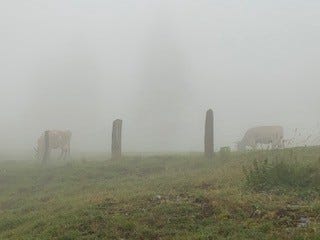

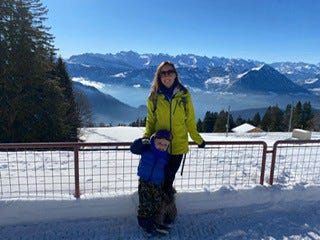
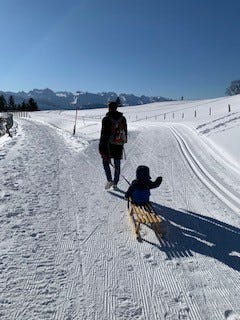

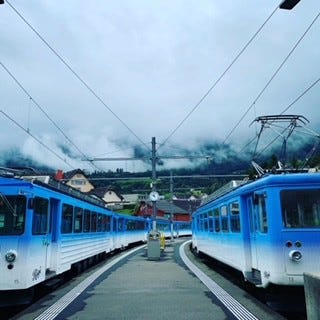
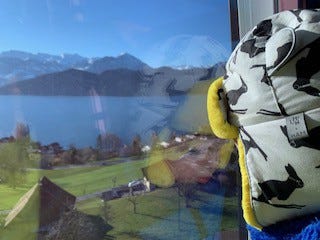
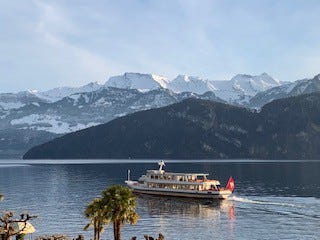

You’ve settled it: I need to visit Switzerland again.
Oh for a transport system like the one in Switzerland. I've only been there once and it was, as you say, spot on. It makes all the difference when you're travelling, especially for complicated trips.
Great article and lovely photos! The foggy ones reminded me of a trip to Kitzbühel, many years ago. We took the cable car to the top of the Hahnenkamm and couldn't see our hands in front of our faces. And there was the time we went to Berlin and the Brandenberg gate, which I particularly wanted to see, was covered with tarpaulin. Things don't always go according to plan. The trick is to make the most of the experience and enjoy the things that do!